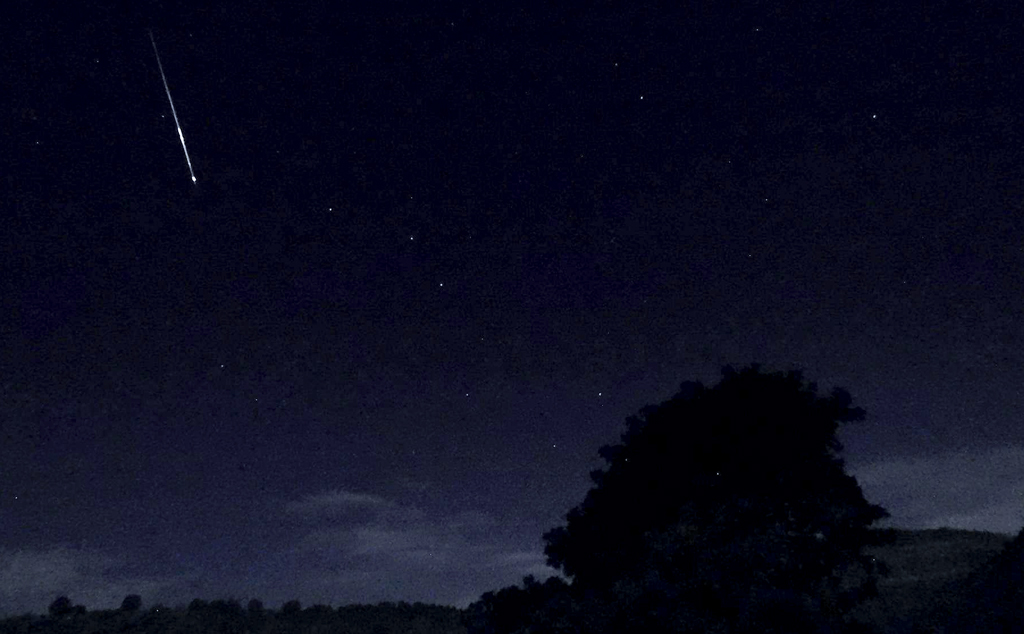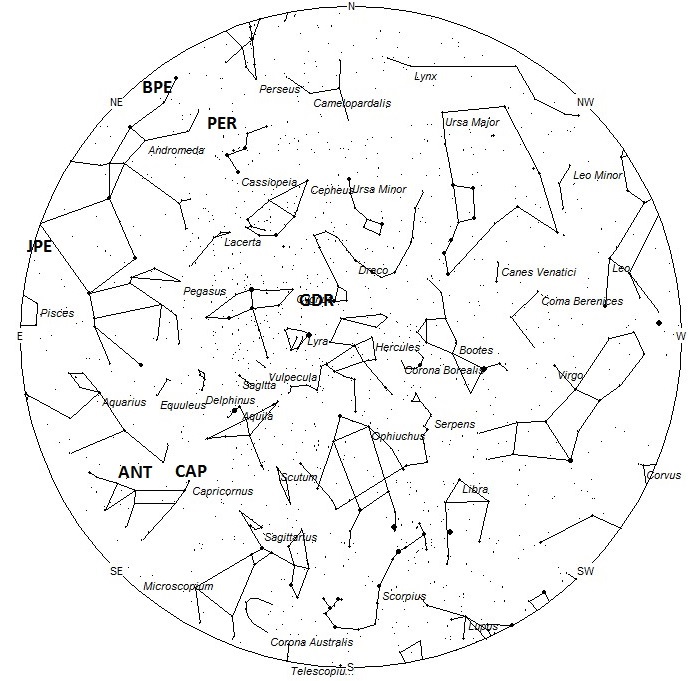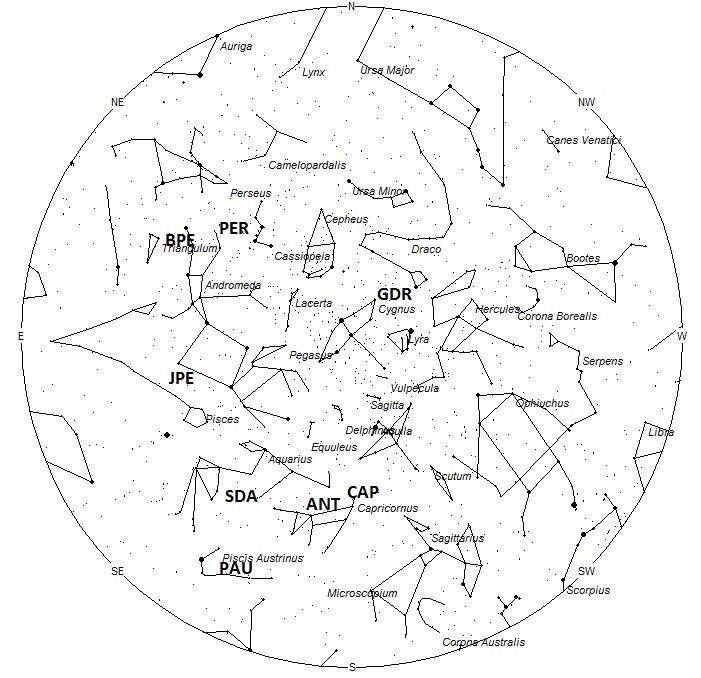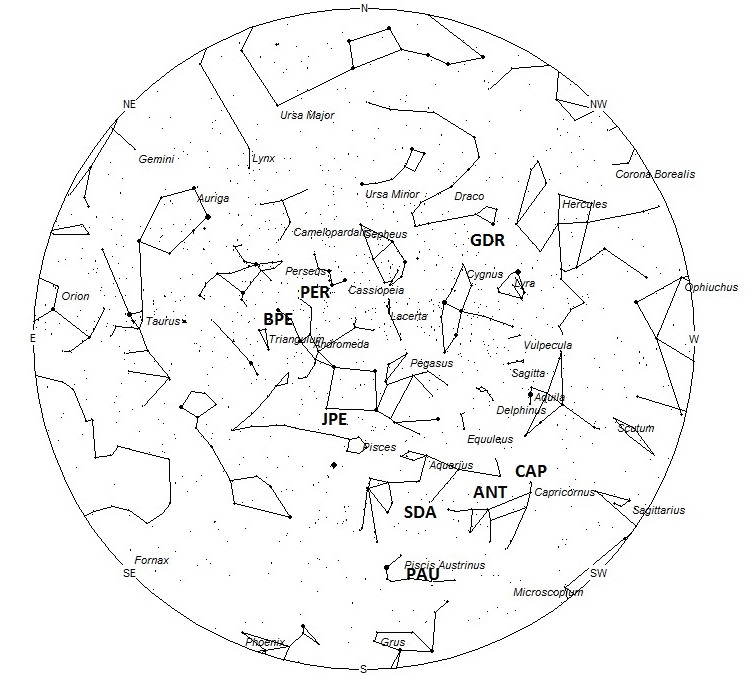
During this period the moon reaches its last quarter phase on Tuesday July 26th. At this time the moon will lie 90 degrees west of the sun and will rise near midnight local daylight saving time (DST) as seen from mid-northern latitudes. This weekend the waning gibbous moon will rise during the late evening hours and will obscure all but the brighter meteors. Conditions for viewing the meteor activity improve with each passing night as the moon’s phase lessens and the moon rises later each morning. The estimated total hourly meteor rates for evening observers this week is near 4 for observers located in the northern hemisphere and 3 for observers located in tropical southern locations (25S). For morning observers the estimated total hourly rates should be near 17 for observers located in the northern hemisphere and 19 for observers located in tropical southern locations (25S). Morning rates are reduced this week due to moonlight. The actual rates will also depend on factors such as personal light and motion perception, local weather conditions, alertness and experience in watching meteor activity. Note that the hourly rates listed below are estimates as viewed from dark sky sites away from urban light sources. Observers viewing from urban areas will see less activity as only the brightest meteors will be visible from such locations.
The radiant (the area of the sky where meteors appear to shoot from) positions and rates listed below are exact for Saturday night/Sunday morning July 23/24. These positions do not change greatly day to day so the listed coordinates may be used during this entire period. Most star atlases (available at science stores and planetariums) will provide maps with grid lines of the celestial coordinates so that you may find out exactly where these positions are located in the sky. A planisphere or computer planetarium program is also useful in showing the sky at any time of night on any date of the year. Activity from each radiant is best seen when it is positioned highest in the sky, either due north or south along the meridian, depending on your latitude. It must be remembered that meteor activity is rarely seen at the radiant position. Rather they shoot outwards from the radiant so it is best to center your field of view so that the radiant lies at the edge and not the center. Viewing there will allow you to easily trace the path of each meteor back to the radiant (if it is a shower member) or in another direction if it is a sporadic. Meteor activity is not seen from radiants that are located far below the horizon. The positions below are listed in a west to east manner in order of right ascension (celestial longitude). The positions listed first are located further west therefore are accessible earlier in the night while those listed further down the list rise later in the night.
These sources of meteoric activity are expected to be active this week.
The July gamma Draconids (GDR) were discovered by both members of SonotoCo and and the IMO in 2009. These meteors are active for only 5 nights centered on July 27th. The radiant is located at 18:42 (281) +51. This area of the sky is located in southern Draco, 5 degrees east of the 2nd magnitude star known as Eltanin (delta Draconis). The radiant is best placed near midnight local daylight time (LDT) when it lies on the meridian and is highest in the sky. With an entry velocity of 26 km/sec., the average July gamma Draconid meteor would be of slow velocity. If one extends the radiant drift into August, it closely matches that of the kappa Cygnids. Therefore this shower may actually be early members of the kappa Cygnids.
The alpha Capricornids (CAP) are active for over a month lasting from July 5 through August 9. Unlike most showers, the Alpha Caps have a plateau-like maximum with maximum activity lasting from July 25-30. Hourly rates this week should be 3-4, no matter your location. The radiant is currently located at 20:16 (304) -11. This area of the sky is located in northwest Capricornus, 1 degree north of the 4th magnitude star known as Algedi (Alpha Capricornii). The radiant is best placed near 0100 LDT when it lies on the meridian and is highest in the sky. With an entry velocity of 22 km/sec., the average Alpha Capricornid meteor would be of slow velocity.
The center of the large Anthelion (ANT) radiant is currently located at 20:56 (314) -15. This position lies in central Capricornus, 3 degrees northwest of the 4th magnitude star known as Dorsum (Theta Capricorni). These meteors may be seen all night long but the radiant is best placed near 0200 LDT when it lies on the meridian and is positioned highest in the sky. Due to the large radiant area, meteors from this source may also appear to radiant from the constellation of Microscopium, southeastern Aquila, western Aquarius, western Piscis Austrinus, and eastern Sagittarius as well as Capricornus. Rates at this time should be near 1 per hour as seen from the northern hemisphere and 2 per hour as seen from south of the equator. With an entry velocity of 30 km/sec., the average Anthelion meteor would be of slow velocity.
The delta Aquariids (SDA) reach maximum activity on the 28th from a radiant located at 22:40 (340) -16. This position is located in southwestern Aquarius, 3 degrees west of the third magnitude Delta Aquarii. Hourly rates this weekend will range from 3 per hour as seen from mid-northern latitudes to 5 per hour visible in southern tropical latitudes. At maximum activity the hourly rates should range will range from 10 per hour as seen from mid-northern latitudes to 20 per hour visible in southern tropical latitudes. The radiant rises near 2200 (10pm) LDT for observers located in the mid northern latitudes, but is best placed near 0300 LDT, when it lies highest in the sky. With an entry velocity of 42 km/sec., most activity from this radiant would be of average velocities.
The Piscids Austrinids (PAU) are a minor shower not well seen from the northern hemisphere. This radiant is active from July 15 through August 10. Maximum activity occurs on July 27th when the zenith hourly rate (ZHR) may reach five. These rates are only seen from the southern hemisphere where the radiant passes overhead. From mid-northern latitudes, rates of one per hour at maximum are usually seen. The radiant is currently located at 22:36 (339) -32. This position lies in southern Piscis Austrinus, 6 degrees southwest of the bright first magnitude star Fomalhaut (Alpha Piscis Austrinus). The radiant is best placed near 0300 LDT, when it lies highest in the sky. With an entry velocity of 35km/sec., most activity from this radiant would be of average velocities.
The July Pegasids (JPE) are active from a radiant located at 23:56 (359) +14. This area of the sky is located in southeastern Pegasus, 4 degrees west of the 3rd magnitude star known as Algenib (Gamma Pegasi). This area of the sky is best seen during the last dark hour before dawn when the radiant lies highest in a dark sky. Maximum activity occurred on July 10th so rates this weekend are expected to be near less than 1 per hour no matter your location. With an entry velocity of 68 km/sec., the average meteor from this source would be of swift velocity.
The Perseids (PER) are active from a radiant located at 01:24 (021) +53. This area of the sky lies on the Cassiopeia/Perseus border, 10 degrees southeast of the 2nd magnitude star known as Schedar (Alpha Cassiopeiae). This area of the sky is best seen during the last dark hour before dawn when the radiant lies highest in a dark sky. Since the maximum is still 3 weeks away, rates are expected to be near 3 per hour as seen from the northern hemisphere and 1 per hour as seen from south of the equator. With an entry velocity of 61 km/sec., the average Perseid meteor would be of swift speed.
The beta Perseids (BPE) are active from July 24th through August 20th with maximum activity occurring on August 7th. The radiant is currently located at 01:56 (029) +41. This position actually lies in eastern Andromeda, 2 degrees southwest of the famous bright double star known as Almach (Gamma Andromedae). Current rates are expected to be less than 1 per hour no matter your location. The radiant is best placed during the last hour before the start of morning twilight when it lies highest in a dark sky. With an entry velocity of 68 km/sec., most activity from this radiant would be swift. This source was previously listed as the alpha Triangulids (ATR)
As seen from the mid-northern hemisphere (45N) one would expect to see approximately 7 sporadic meteors per hour during the last hour before dawn as seen from rural observing sites. Evening rates would be near 3 per hour. As seen from the tropical southern latitudes (25S), morning rates would be near 6 per hour as seen from rural observing sites and 2 per hour during the evening hours. Locations between these two extremes would see activity between the listed figures. Morning rates are reduced this week due to moonlight.
The table below presents a list of radiants that are expected to be active this week. Rates and positions are exact for Saturday night/Sunday morning except where noted in the shower descriptions.
| SHOWER | DATE OF MAXIMUM ACTIVITY | CELESTIAL POSITION | ENTRY VELOCITY | CULMINATION | HOURLY RATE | CLASS |
|---|---|---|---|---|---|---|
| RA (RA in Deg.) DEC | Km/Sec | Local Daylight Saving Time | North-South | |||
| July gamma Draconids (GDR) | Jul 27 | 18:42 (281) +51 | 26 | 00:00 | <1 – <1 | IV |
| alpha Capricornids (CAP) | Jul 26 | 20:16 (304) -11 | 22 | 01:00 | 3 – 4 | II |
| Anthelions (ANT) | – | 20:56 (314) -15 | 29 | 02:00 | 1 – 2 | II |
| delta Aquariids (SDA) | Jul 28 | 22:40 (340) -16 | 42 | 03:00 | 3 – 5 | I |
| Piscids Austrinids (PAU) | Jul 27 | 22:36 (339) -32 | 35 | 03:00 | <1 – 1 | II |
| July Pegasids (JPE) | Jul 10 | 23:56 (359) +14 | 68 | 04:00 | <1 – <1 | IV |
| Perseids (PER) | Aug 12 | 01:24 (021) +53 | 61 | 05:00 | 3 – 1 | I |
| beta Perseids (BPE) | Aug 07 | 01:56 (029) +41 | 61 | 06:00 | <1 – <1 | IV |
 American Meteor Society
American Meteor Society



Just seen a huge blue green fireball in Robinsonville Mississippi! It was beautiful!!